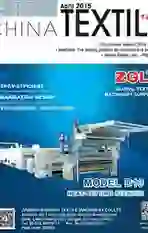Jeans make a comeback this summer
2015-12-31ByZhengRan
By+Zheng+Ran
History
Jeans are trousers typically made from denim or dungaree cloth. Often the term “jeans” refers to a particular style of pants, called “blue jeans”, which were invented by Jacob Davis in 1871 and patented by Davis and Levi Strauss on 20 May 1873. Starting in the 1950s, jeans, originally designed for cowboys and miners, became popular among teenagers, especially members of the greaser subculture. Historic brands include Levis, Lee, and Wrangler. Jeans come in various fits, including skinny, tapered, slim, straight, boot cut, narrow bottom, low waist, antifit, and flare. Owing to their high durability as compared to other common fabrics,“distressed” (visibly aged and worn, but still intact and functional) jean trousers have become increasingly fashionable, making pre-sale “factory distressing” a common feature in commercially-sold jeans.
Manufacturing processes
·Dyeing
Traditionally, jeans were dyed to a blue color using natural indigo dye. Most denim is now dyed using synthetic indigo. Approximately 20 thousand tons of indigo are produced annually for this purpose, though only a few grams of the dye are required for each pair. For other co- lours of denim other dyes must be used. Currently, jeans are produced in any color that can be achieved with cotton.
·Pre-shrinking
In 1963 Levi Strauss introduced preshrunk jeans, which did not shrink further after purchase, allowing the consumer to buy his or her correct size.[18] These jeans were known as the 505 regular fit jeans. The 505 are almost identical to the 501s with the exception of the button-fly. The Levis Corporation also introduced a slim boot-cut fit known as 517 and 527. The difference between the two is 517 sit at the waist line and the 527 sit below the waist line. Later, Levis would develop other styles and fits such as the loose, slim, comfort, relaxed, skinny, and a regular fit with a tapered leg.
·Used look
The used or “acid wash” look is created by means of abrading the jeans and/ or treating them with chemicals, such as acryl resin, phenol, a hypochlorite, potassium permanganate, caustic soda, acids etc.
·Sandblasting or abrading with sandpaper
Consumers wanting jeans that appear worn can buy jeans that have been specially treated. To give the fabrics the worn look, sandblasting done with chemicals or by adding pumice stone to the wash- ing process or abrading with sandpaper is often done.
·Environmental and humanitarian impact
A typical pair of blue jeans consumes 919 gallons (3479 liters) of water during its life cycle. This includes the water to irrigate the cotton crop, manufacture the jeans, and the numerous washes by the consumer.
The production of jeans with a “used look” can be more environmentally damaging than regular jeans, depending on how the waste compounds are processed. Sandblasting and treating with sandpaper has the risk of causing silicosis to the workers, and in Turkey, more than 5,000 textile workers have been stricken with this disease, and 46 people are known to have died. Some companies have announced they are banning the use of sandblasting.
Worldwide market for jeans
North America accounts for 39% of global purchases for jeans, followed by Western Europe at 20%, Japan and Korea at 10% and the rest of the world at 31%. United States citizens spent more than US 14 billion dollars on jeans in 2004 and US 15 billion dollars in 2005. US people bought US 13.8 billion dollars of mens and womens jeans in the year which ended 30 April 2011, according to market-research firm NPD Group.
Jeans with charm will shine Shanghai this June
Although these years, the global market, with sales down year over year, is blue on jeans, this summer, 2015 2nd Shanghai International Jeans Wear Expo will hit the headlines in the trading and fashion circles.
The coming edition will be held on June 17th, 2015, when it attracts numerous experts, enterprises, media from related industry. Meanwhile, the exhibition gains guidance as well as support from authoritative institutions and associations, such as the parks in the counties of Xintang, Junan, Sanfu, Dayong; the international brands from Italy and Japan. On the show, the audiences could not only appreciate the jeans innovation and trend, but the opportunities for developing related market both at home and abroad.
Good to know
Care and wear: Despite most jeans being “pre-shrunk”, they are still sensitive to slight further shrinkage and loss of color from being washed. The Levi Strauss company recommends avoiding washing jeans as much as possible. Carl Chiara, Levi Strauss director of brand and special projects, has a credo: “The less you wash your jeans, the better your jeans become.” These and other suggestions to avoid washing jeans where possible have encountered criticism. Cory Warren, editor of LS&Co. Unzipped, clarifies in a response to such a criticism:
“Our advice is to wash less often, but clearly, you have to judge for yourself whats appropriate. Hot day, dirty job? Wash your jeans. Please! Cold day, office job? Maybe you can wear them twice or more before they go back to the washing machine. Personally, if I wear a pair of jeans to work on Friday—cool climate, office job—I tend to wear them on Saturday. And if Saturday is spent indoors and Im not spilling food all over myself, I might even wear them on Sunday.”
For those who prefer to refrain from washing their jeans there have been suggestions to freeze them in order to kill the germs that cause odor. However, this advice has been disputed as ineffective and replaced with the suggestion of baking them for ten minutes at 250 degrees Fahrenheit.
杂志排行
China Textile的其它文章
- Xingang:Focusing on energy savingwith higher efficiency
- CMT-HICORP Machinery:To seek more opportunities in Indonesia
- Jilong Machine:Bringing new machines to global market
- Jiangyin Dongjie:Professional in textile machinery special parts
- Indonesia Shows:To shine in April
- ZGL:On a never-ending route to innovation Overview
